WARHOLSTARS JUNE - DECEMBER 1964
1928 - 1959 - 1960 -1962 - 1963 - Jan - May 1964 - June-December 1964 - 1965 - 1966 - 1967 - 1968 -1969 - 1970 - 1974 - 1975 - 1979 - 1980s+
JUNE 1964: LOU REED GRADUATES FROM COLLEGE.
Reed graduated from the Syracuse College of Arts and Sciences with a bachelor of arts degree and moved back to his parent's home in Freeport. From September 1964 - February 1965 he worked for a bargain basement recording company, Pickwick International, in Long Island City, writing "made-to-order pop songs" for $25.00 a week and no rights to any of the material. (LR73/77)
At Pickwick Lou Reed met John Cale. Terry Phillips, one of the owners of Pickwick met John at a party and asked him to the studios with the possibility of being in a band with Lou to perform what Pickwick hoped would be a hit dance craze single, The Ostrich, which Reed had written for Pickwick. The single bombed, but Lou Reed and John continued their friendship.
Lou Reed:
"There were four of us literally locked in a room writing songs. They would say, 'Write ten California songs, ten Detroit songs,' they we'd go down into the studio for an hour or two and cut three or four albums really quickly which came in handy later because I knew my way around a studio, not well enough but I could work really fast. One day I was stoned and (after reading in Eugenia Sheppard's column that ostrich feathers were big that season) just for laughs - I decided to make up a dance. So I said, 'You put your head on the floor and have somebody step on it!' It was years ahead of its time. And another thing called Sneaky Pete. And when they heard it they thought it could be a single, so we needed people who could be a group to out and promote it."
Lou was still living with his parents in Freeport when he first started working at Pickwick - but would spend a lot of time at John Cale's apartment at 56 Ludlow Street in Manhattan. Their mutual interests were music and heroin. When John Cale's flatmate moved out, Lou moved in. (LR81-5) Their neighbour was Angus MacLise, a Scotsman who often played drums in La Monte Young's Theatre of Eternal Music - who Cale also worked with. It was Angus who introduced Lou to methamphetamine hydrochloride ("speed").
Lou Reed (from a tape made by Nat Finkelstein at the Factory in Autumn 1966):
"We were playing together a long time ago, in a $30-a-month apartment and we really didn't have any money, and we used to eat oatmeal all day and all night and give blood... or pose for these nickel or 15 cent tabloids they have every week. And when I posed for them, my picture came out and it said I was a sex maniac killer that had killed 14 children and tape recorded it and played it in a barn in Kansas at midnight. And when John's picture came out in the paper, it said he had killed his lover because his lover was going to marry his sister, and he didn't want his sister to marry a fag.
And then we decided that since we were playing all the time anyway, why not try to get paid for it, so we ended up at a terrible coffee house working six sets a night, seven nights a week, $5 a man a night, and that lasted a week-and-a-half and we were fired, because they hated our music so much. And then we met Andy. And we're now able to play the kind of stuff we really like to play...." (UT91-2)
JUNE 1964: ANDY WARHOL PAINTS FLOWERS.
During the same year that Warhol started his Flower paintings, Marimekko brought out their signature flower trademark:
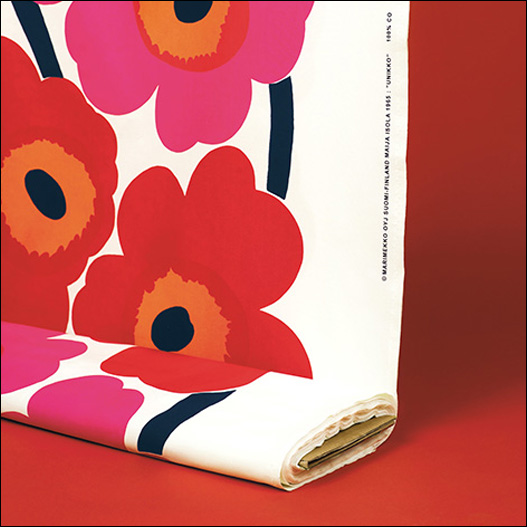
NOT a Warhol flower - but a similar shaped flower pattern (designed by Maija Isola) that was introduced by Marimekko the same year that Warhol produced his Flower paintings
Andy Warhol's first exhibition at the Leo Castelli Gallery in November 1964 consisted of his Flowers paintings. The works were based "on a series of reproductions accompanying an article about colour processing in the June 1964 issue of Modern Photography, to illustrate the effect of different exposure times and filter settings, the same transparency taken by the magazine's executive editor, Patricia Caulfield, was reproduced several times." (RNA282) When Caulfield later threatened to sue Warhol, she was offered two sets of Flowers portfolios as payment for the use of her work, but she declined the offer and a cash settlement was arranged.
Gerard Malanga:
"Andy realized that he had to be very careful about appropriating for the fear of being sued again. He opted to start taking his own photographs. His entry into photography vis a vis his creation of silkscreen paintings was done out of necessity." (AWP116)
As was his usual practice, Warhol worked closely with his screen maker while doing the Flowers, asking that the image be manipulated according to his specific instructions. Among the instructions that Warhol issued for some of the Flowers was to heighten the image's contrast and "extracting and replicating" the centers as noted in the catalogue raisonné: "Not only was Warhol following his characteristic procedure by instructing the screen maker to heighten the image's contrast, he was going one step better by extracting and replicating the centers, where they were darkest and could be most easily read..." In regard to one acetate, Warhol instructed the screen maker to "break the final enlargement into two installments and four matching screens: 'Mr Golden (2 section/4 screens) for now do only top picture.' As Warhol's calculations and diagrams in the right margin make plain: the 82-inch paintings invoiced at the end of August were based on a 40-inch module, commensurate to the Marilyn and Jackie heads made that summer and comparable to the 48-inch Flowers of late June..." (RNA282)
The first invoice for the Flowers screens was dated June 22, 1964:
From the Andy Warhol Catalogue Raisonné (Vol. 2A):
"The first [Flowers] silkscreen invoice dates from as early as June 22 for the 48 by 48-inch series, followed by another, on August 28 for 82 by 82 inches. A third invoice, dated October 29, specifies both the 60 by 60 and the 24 by 24 inch series, produced in the month before the Castelli show... Several 48-inch Flowers were included in the first consignment of Warhol's works to Castelli in late September, but it was not until November 11 that a substantial number of paintings entered the gallery: a consignment of forty-five 24-inch paintings. On November 20, the day before the show opened, eight 82- inch paintings, six more 48-inch, two 60-inch, and one large Flowers, recorded as measuring 82 by 162 inches, were inventoried at Castelli. The exhibition was selected from the November consignments, although no 60-inch paintings were included." (RNA281/283-84)
Smaller Flowers were produced for an exhibition at the Ileana Sonnabend Gallery in Paris which took place in May 1965. Some were originally commissioned by Robert and Ethel Scull.
From the Andy Warhol Catalogue Raisonné (Vol. 2A):
"...The Flowers constituted a set of works, consisting of several graduated series. This would become explicit in December while the Castelli show was on view and Warhol had Flowers screens fabricated in a diminishing series, based on the dimensions of 22 by 22, 14 by 14, 8 by 8, and 5 by 5 inches. These were produced for an exhibition at Ileana Sonnabend, Paris in May 1965... although the 22-inch canvases were originally commissioned as a mural for Robert and Ethel Scull..." (RNA281)
JUNE 26, 1964: LIFE MAGAZINE PUBLISHES "HOMOSEXUALITY IN AMERICA."
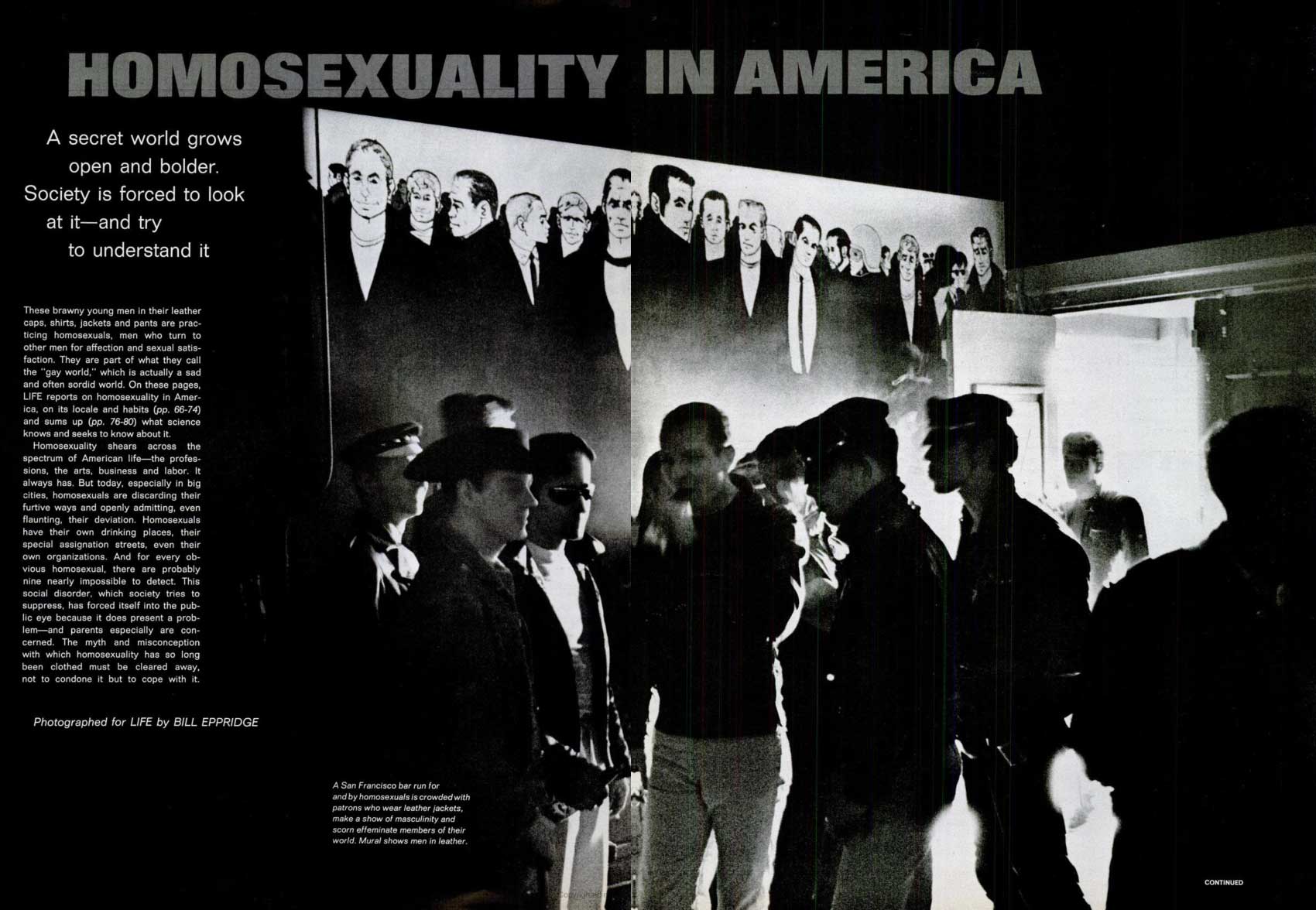
Ernest Haveman, "Homosexuality in America," Life magazine, June 26, 1964
JULY 1964: STEVE PAUL'S THE SCENE OPENS.
Steve Paul's nightclub was described in a New York Times article the following year:
John S. Wilson ("Where the Show Crowd Goes to Make The Scene," New York Times, May 26, 1965):
"Down in a catacomb under the northwest corner of Eight Avenue and 46th STreet, a tall, nervously energetic 23-year-old named Steve Paul has what he considers '5,000 square feet of canvas' on which he is attempting to justify his existence as a creative person.
His 'canvas' is a nightclub, The Scene, which, since its opening last July, has become a hangout for young theater people who are often a part of the club's floor show along with members of its staff and such volunteer visitors as Sammy Davis, who has stopped in several times to perform after his night's work nearby in Golden Boy, Leslie Uggams, Liza Minnelli, and Paula Wayne, who is also in Golden Boy...
In addition to show business patrons, The Scene is also attracting many others as word spreads of its reputation as a place for 'swingers.' The jet set is showing interest and among those at a party on Monday night were Huntington Hartford, Ann Ford and Wendy Vanderbilt."
JULY - AUGUST 1964: ANDY WARHOL PAINTS 40 BY 40 INCH MARILYNS AND JACKIES - INCLUDING WORKS LATER KNOWN AS SHOT MARILYNS.
The silkscreens for both the Marilyns and Jackies of these series were on the same invoice dated July 16, 1964. (RNA272) Some of the Marilyns were called Shot Marilyns after they were shot with a gun by Dorothy Podber when she visited the Factory. Not all the Marilyns from this period were shot of course. Rainer Crone called four of the Marilyn paintings Shot Marilyns in his 1970 catalogue raisonné of Warhol's works, although, according to the current Andy Warhol Catalogue Raisonne (Vol 2A), only two of the paintings show evidence of damage.
From the Andy Warhol Catalogue Raisonné (Vol. 2A):
"Crone called four of the five 40 by 40 inch Marilyn paintings "Shot" Marilyns in reference to an incident that occurred at the Factory, probably not long after the works were made. The paintings were in the studio... with the blue canvas stacked in front of the red, when Dorothy Podbur [sic], whom Warhol knew and wanted to include in one of his films, fired a gun at the forehead of Blue Marilyn (cat. No. 1292), damaging it and the Red Marilyn (cat. no. 1290) to a lesser degree. Although Crone identified both the orange (cat. no. 1291) and phthalo blue canvases (cat. no. 1293) as Shot Marilyns (he called the latter Shot Sage Blue Marilyn), only the cerulean blue and cadmium red versions show any damage or evidence of having been in-painted between the eyes." (RNA272)
The 40 by 40 inch format had been used previously by Warhol in 1963 for his Liz series. He used the same photograph of Marilyn for this series as he had used for his 1962 Marilyns. However, he used a different photograph of Jackie for his 40 by 40 inch paintings than the one he used for his 20 by 16 inch Jackies.
From the Andy Warhol Catalogue Raisonné (Vol. 2A):
"With a different group of Jackie paintings, and a contemporaneous set of Marilyn heads from mid-1964, Warhol revived the 40 by 40 inch portrait format introduced the previous year for the Liz series... The impetus behind both 40 inch series is not known... The Marilyn paintings were based on the same photograph that Warhol has used in his 1962 series... The square format of the 1964 paintings, however, dictate that the image be cropped differently... Between the 20 by 16 inch and 40 by 40 inch Jackies, there is a shift in both format and source. The latter was based on a photograph by Jacques Lowe... Kennedy's official photographer, Lowe had been granted unprecedented access to the White House... The photograph of Jackie that Warhol used was taken at the Kennedy compound in Hyannisport during the spring or summer of 1960..." (RNA272)
Warhol worked from a reproduction of one of Lowe's photographs of Jackie in a souvenir book. He would mostly stick to the 40 by 40 inch format used for this series of Jackies and Marilyns when he did his portraiture of the 70s and 80s.
From the Andy Warhol Catalogue Raisonné (Vol. 2A):
"Unlike the 20 by 16 inch Jackies, the 'Hyannisport' Jackies are pure portrait types, seeming devoid of temporal reference or spatial coordinates. On occasion after 1964, Warhol revisted the photobooth and experiemented with other sizes and formats for commissioned portraits, however, when he began to take up portraiture as a sustaining practice during the 1970s and 1980s, almost without exception, the 40 by 40 inch format never varied, although the icon-like formula of the 1964 Marilyn and Jackie paintings might be embellished by gestural or painterly incident." (RNA272)
SUMMER 1964: EDIE SEDGWICK MOVES TO NEW YORK.
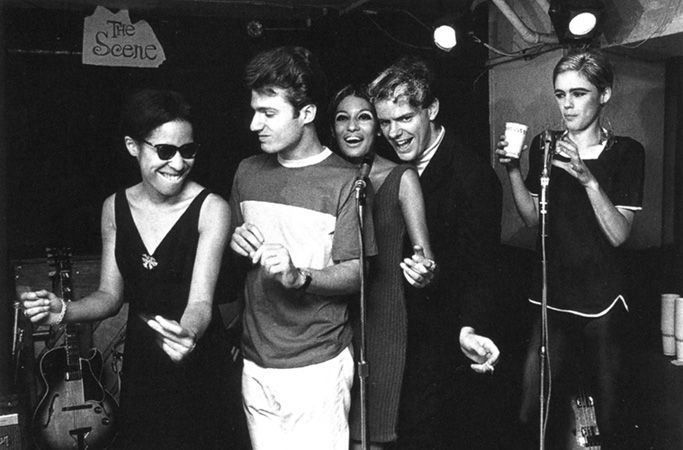
Left: Dorothy Dean and Gerard Malanga, Right (on mic): Edie Sedgwick at Steve Paul's The Scene nightclub, 1965 (Photo: David McCabe)
Eddie arrived in New York in her gray Mercedes Benz in the company of GORDON BALDWIN and moved into her bedridden grandmother’s fourteen room apartment on Park Avenue and 71st Street. Edie modeled for a teen magazine and dined at L’Aventura, spending her nights partying at the “in spots - Harlow, Shepheard’s, Ondine, Arthur or Steve Paul’s The Scene.” (UV205)
1964: BABY JANE HOLZER APPEARS IN SOAP OPERA.
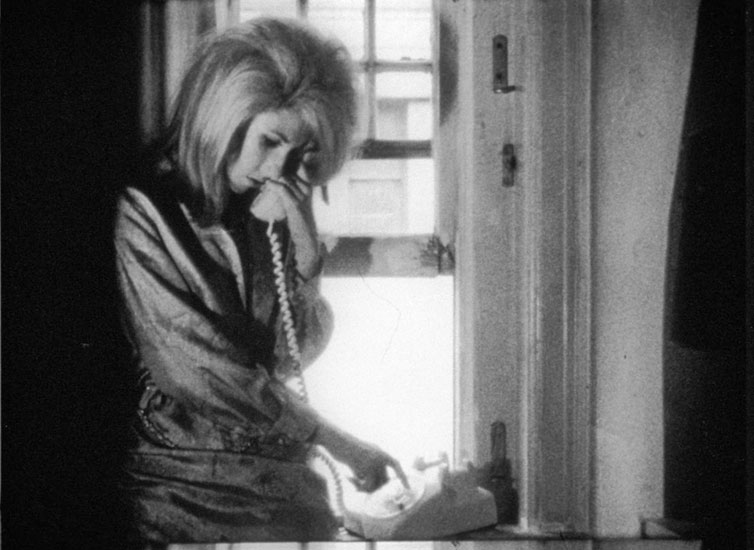
Jane Holzer in Andy Warhol's film, Soap Opera
SOAP OPERA was filmed over P.J. Clarke’s, the Third Avenue pub. It was subtitled THE LESTER PERSKY STORY in tribute to Andy's friend who would eventually became a movie producer. Andy spliced parts of the commercials that Lester made into segments of SOAP OPERA. (POP60) Jane Holzer was “the beautiful young Park Avenue socialite wife of a wealthy businessman.” (L&D194)
JULY 1964: ANDY WARHOL FILMS BATMAN DRACULA.
Andy Warhol's film, Batman Dracula, was a collaboration with Jack Smith which was never finished. (CB) It featured GREGORY BATTCOCK, DAVID BOURDON, RUFUS COLLINS, BABY JANE HOLZER, MARK LANCASTER, GERARD MALANGA, IVY NICHOLSON, MARIO MONTEZ, ONDINE, JACK SMITH and NAOMI LEVINE who Andy called his "first female superstar." (POP32) Wynne Chamberlain and Gerard Malanga had introduced Naomi Levine to Andy Warhol at a performance at the Living Theater on Sixth Avenue and 14th Street, and they they all went to a black-tie opening at the Museum of Modern Art. Naomi was very “film studentish” - working at F.A.O. Schwarz, the toy store on Fifth Avenue, but also making films. One of her films was confiscated and destroyed by a New York lab because of the nudity in it. (POP43/44)
to filmography
SUMMER 1964: MARK LANCASTER AND GERARD MALANGA KISS IN A KISS MOVIE. (POP71)
Although Stephen Koch's filmography which was based on Jonas Mekas' filmography dates the Kiss films Nov/Dec 1963, Warhol (via Pat Hackett) noted in Popism that they were still shooting KISS films in the summer of 1964.
JULY 1964: ANDY WARHOL FILMS COUCH.
JULY 25 - 26, 1964: ANDY WARHOL FILMS EMPIRE.
Although Empire was filmed in July 1964, it would not have its public premiere until the following year on March 6, 1965 according to an ad in the Village Voice.

Village Voice ad, March 4, 1965, p. 15 (Note that the film is equally credited to Andy Warhol and John Palmer)
Jonas Mekas was using the City Hall Cinema as the Filmmakers' Cinematheque at the time - see "Jonas Mekas and the Film-Makers' Cinematheque, p. 3," here.
Warhol used an Auricon camera after seeing JONAS MEKAS’ The Brig which was filmed with an Auricon movie camera.
The Auricon was often used by journalists to shoot live events because the camera recorded sound directly on the film - a "single system" camera. The sound quality was primitive but it had sync sound.
Jonas Mekas:
"He [Warhol] decided to shoot Empire, which was mostly John Palmer's idea. And since it needed long takes - it's a long film - he asked me what he should use, and I said, 'Why don't you use - you know - we can use Auricon. That's the cheapest. I already had rented [one]. We can, you know, just take it.' And he [Warhol] was interested because he wanted to get used to it because he wanted, he said, he wanted to go and shoot sound films with it. You know - in the way of The Brig. And since I knew how to operate it, I became the camera man for it." (PS416)
JOHN PALMER who Mekas credited with the idea for Empire would later co-direct/write the non-Warhol film Ciao Manhattan, starring Edie Sedgwick.
Warhol and entourage shot the Empire State building from an office in the Time-Life Building that belonged to HENRY ROMNEY who was also trying to buy the rights to the book A Clockwork Orange so that Andy could film it using NUREYEV, MICK JAGGER and BABY JANE HOLZER. (POP80) Warhol would later make his own version of A Clockwork Orange - VINYL starring Gerard Malanga and Edie Sedgwick.
1964: JOE DALLESANDRO IS ARRESTED.
At the age of sixteen, Joe Dallesandro, living with his father in Queens, stole a car (one of many) and crashed through the toll gate at Holland Tunnel, pursued by six squad cars. The cops stopped the speeding vehicle with a road block. The officers came out of their cars with their weapons drawn.
When Joe opened the door and started to step out of the stolen car, one of the officers opened fire, the others followed, and Joe retreated back into the car which he then proceeded to drive straight at them. One of their bullets wounded him above the kneecap in his right leg. He managed to escape the cops, sinking the car in the Hudson River, and stole another car which he drove back to his father’s house.
His father took him to the hospital and he was arrested and charged as a juvenile. He was sentenced to four months in the Camp Cass Rehabilitation Center for Boys in the Catskills, where (according to him) he tattooed himself with the Little Joe tattoo.
He escaped from the center, returned to his father and received a “dishonorable parole” from the authorities stating that if he committed another crime before turning 21, he would have to finish the time he still had to do at Camp Cass, plus time for the new crime.
1964: JOE DALLESANDRO GOES TO MEXICO.
Joe and a friend named Stanley ended up going to Mexico (Ciudad Juarez) with money Joe stole from the safe of an RKO theatre in Brooklyn managed by a gay friend. In Mexico, Joe Dallesandro worked as a busboy and dishwasher in exchange for breakfast, lunch and cigarettes. (JOE16-7)
FALL 1964: EDIE SEDGWICK MOVES TO HER OWN APARTMENT.
Edie's apartment was on E. 63rd Street between Fifth and Madison. She hired a friend from Cambridge, TOM GOODWIN, as a chauffeur for $100 a week. After he crashed Edie's car in front of the Seagram Building, she leased a limo from Bermuda Service, tipping the driver handsomely, but rarely paying her bills. (UV205)
1964: ANDY WARHOL THROWS A SURPRISE PARTY
Warhol hosted a surprise party at the Factory to celebrate the 1963 marriage of Billy Klüver and Olga Adorno. Klüver collaborated with Warhol on the Silver Clouds. Warhol filmed two Screen Tests of Olga - one of which was included in The Thirteen Most Beautiful Women. Olga was an artist and performer who appeared in early Happenings. She also appeared in Allan Kaprow's presentation of Stockhausen's Originale at the Judson in NY and had her leg cast in plaster by Jasper Johns for Watchman (1964) (AD110)
SEPTEMBER 1964: ANDY FILMS TAYLOR'S ASS.
Warhol filmed Taylor Mead's ass and appropriately called the 70 minute film, TAYLOR MEAD’S ASS (70mins/16 fps/black & white/silent). (UV157/SG145)
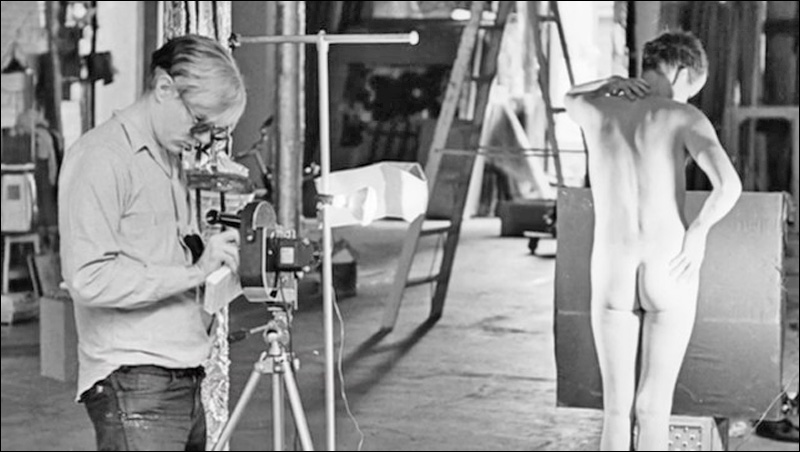
Detail from a photograph of Andy Warhol filming Taylor Mead's Ass (1964) (Photographer William John Kennedy, Kiwi Arts Group)
Kelly M. Cresap (Pop Trickster Fool: Warhol Performs Naivete (Chicago: U. of Illinois Press, 2004), p. 196):
"For the duration of the film, Taylor Mead's Ass, Mead does indeed gamely sport his behind for the camera. In one sequence he pretends to remove a variety of items from his anal sphincter, including vacuum cleaner accessories, the torso of a mannequin, a roll of industrial tape, and a publicity still of Rhett Butler and Scarlett O'Hara from Gone with the Wind."
LATE SEPTEMBER 1964: ANDY WARHOL JOINS THE LEO CASTELLI GALLERY.
According to page 026 of the second volume of the Andy Warhol Catalogue Raisonné, Warhol joined the Castelli Gallery in "late September 1964." Page 280 of the same volume of the cat. rais. notes that "during the summer of 1964, at the end of the gallery season, Warhol left the Stable Gallery to join Leo Castelli Gallery, although no works were consigned to Castelli until the beginning of the next season in late September. This left Warhol comparatively free during the summer, when he was effectively between dealers, to take on a variety of independent projects, such as the Watson Powell portrait and the 40 inch Marilyn and Jackie paintings, and to attempt to settle unresolved issues, such as the World's Fair Commission. At the same time, it seems likely that Warhol was preparing for his exhibition at Castelli, which took place November 21 through December 17." (RNA280)
OCTOBER 1964: BABY JANE HOLZER APPEARS IN VOGUE MAGAZINE.
Jane's mane of big hair created a new fashion trend. (AD97)
OCTOBER 1964: THE ROLLING STONES HAVE A PARTY. (SO DOES BABY JANE.)
The party was arranged by NICKY HASLAM and friends at JERRY SCHATZBERG’s photography studio on Park Avenue South to generate publicity for THE ROLLING STONES who are in New York to appear on the Ed Sullivan Show and play at the Academy of Music on 14th Street. It was also JANE HOLZER’s 24th birthday and the event became a birthday party for her, with the Stones as the star guests. Jane had been modeling for Vogue magazine so TOM WOLF was sent to cover the event for the New York Herald Tribune Sunday magazine supplement. He wrote his Girl of the Year article about Jane which was included in his book Kandy-Kolored Tangerine-Flake Streamline Baby. (POP80/81) The article was originally published in the December 1964 issue of New York magazine.
OCTOBER 26, 1964: HOLLY WOODLAWN IS ALMOST DRAFTED.
Holly was called up for the draft on her eighteenth birthday during the Vietnam War. (S)he showed up at the draft board wearing “hot pants and sandals, with a dab of blush for color," and was excused from service when the doctor noticed that (s)he had breasts (as a result of hormone treatments). (HW83)
OCTOBER 27, 1964: FRED HERKO DANCES HIMSELF TO DEATH.
Andy Warhol (via Pat Hackett in POPism: The Warhol Sixties)
:
"Freddy spent the months before he died with a girl dancer over in an apartment near St. Mark's Church, taking more and more amphetamine... One night he showed up at Diane di Prima's to borrow a record and invited everyone there to a performance; he said he was going to leap off the top of his building downtown.
A few days later, on October 27, he turned up at an apartment on Cornelia Street that belonged to Johnny Dodd, who did the lighting for the Judson Church concerts... What Freddy did when he got inside was go and take a bath... After his bath, Freddy put Mozart's Coronation Mass on the hi-fi... As the record got to the 'Sanctus,' he danced out the open window with a leap so huge he was carried halfway down the block onto Cornelia Street five stories below." (POP85)
In 1974 one of Herko's close friends, the poet Diane di Prima, would bring out a book called Freddie Poems. Some of the poems were written before his death, including this one, written in December 1959, in which she appears to criticise him for his sexual habits:
FOR FREDDIE, FUCKING AGAIN
I think it's disgusting
to be offcourse, in love
midwinter afternoons is excusable
especially if it rainsbut how is it you are always offcourse these days
& not that much in love,
will you never grow up
at least if you'd gone off to gather those blue flowers
(are they called periwinkles?)
or mussels, from the sea weed
but no, you're off for adventure in grimy bars
and the props not finishedI think it's pretty bad -
The book contained photos by George Hermes in addition to di Prima's poems. In "Formal Birthday Poem: February 23, 1964" she chastises him for shooting up A (Amphetamine) and tells him he is "really gone now, crazy like any other old queen."
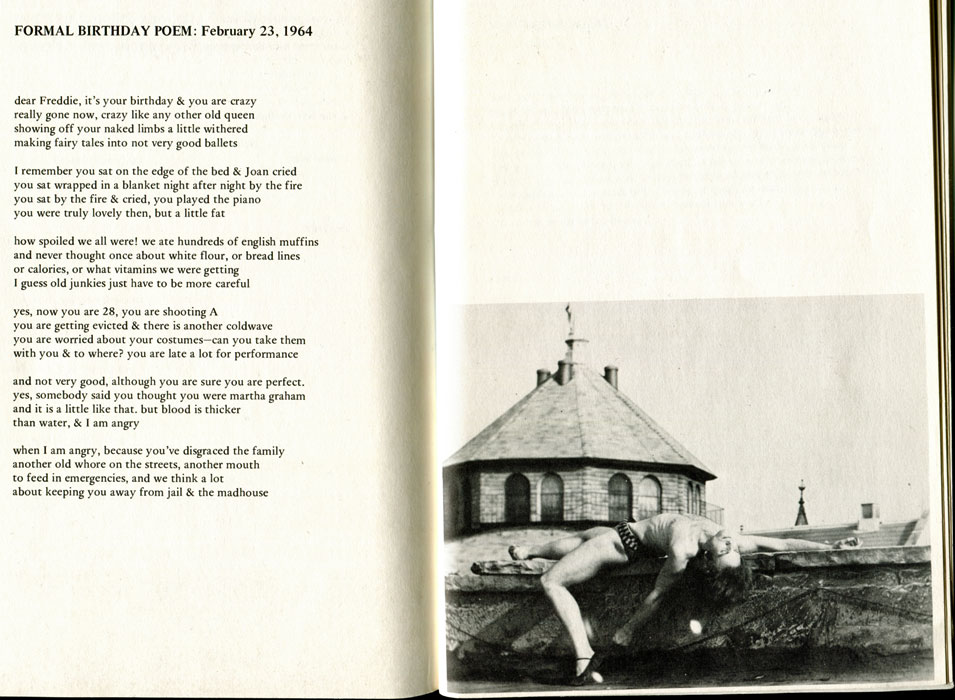
Diane di Prima, Freddie Poems (Point Reyes: Eidolon Editions, 1974)
NOVEMBER 5, 1964: A MEMORIAL SERVICE IS HELD AT THE JUDSON CHURCH FOR FRED HERKO. (JD209)
NOV. 21 - DEC. 17, 1964: ANDY WARHOL'S FIRST SHOW AT THE LEO CASTELLI GALLERY.
Warhol's first exhibition at the gallery of his new dealer, Leo Castelli, consisted of his Flower paintings. The Flowers sold well, both at the time of the exhibition and as part of Castelli's inventory during 1965. (RNA284) Warhol dedicated a white Flowers painting to the memory of Freddy Herko. (AD93)
1964: HOLLY WOODLAWN GETS A JOB.
Holly worked at JC Penney’s on Seventh Avenue and Sixty-first Street as a (female) file clerk to pay off debts from using her boyfriend's credit card, after quitting a school where she was training to become a key punch operator. (HW87) She later got a job as a salesgirl in the Seventh Heaven Boutique at Saks Fifth Avenue and eventually did floor modeling for Saks, participating in private fashion shows for the more exclusive clients. Fed up with the negative comments from the clientele at Saks, she found jobs modeling at different fashion houses, including Morris Metzger’s where she modeled sportswear for buyers. Eventually, she left modeling completely to become a file clerk in the Hounds Department at the American Kennel Club. (HW90-91)
1964: CANDY DARLING GETS A JOB.
Candy worked as a (female) file clerk at an investment firm on Wall Street. She did so well that she got an advancement to front-office receptionist. She went through an intellectual phase carrying a copy of Tolstoy’s War and Peace wherever she went. (HW88)
DEC. 7, 1964: ANDY WARHOL RECEIVES THE INDEPENDENT FILMMAKERS' AWARD.
The award, from Film Culture magazine, was for SLEEP, HAIRCUT, EAT, KISS and EMPIRE. (PS419/DB193)
The event took place at the New Yorker Theater on 89th Street and Broadway. Excerpts from The Thirteen Most Beautiful Women and The Thirteen Most Beautiful Boys (Freddy Herko's Screen Test) were shown.
The independent filmmaker, Stan Brakhage, resigned from the Film-Makers' Co-op when Andy Warhol won the award. In a letter to Jonas Mekas, he wrote, "I cannot in good conscience continue to accept the help of institutions which have come to propagate advertisements for forces which I recognize as among the most destructive in the world today: "dope", self-centred Love, unqualified Hatred, Nihilism, violence to self and society." (LD212)
Jonas Mekas made a 12 minute film called Award Presentation to Andy Warhol featuring Warhol handing out fruit to a group that included Baby Jane Holzer, Gerard Malanga, Ivy Nicholson (and her young son), Naomi Levine, Gregory Battcock, Gregory Markopoulos and Kenneth King. Holzer got a banana which she peeled and ate in the film. (VWB3/4)
DECEMBER 16, 1964: GERARD MALANGA GIVES A POETRY READING AT THE LEO CASTELLI GALLERY.
Gerard Malanga gave a poetry reading while Warhol's Flowers were being exhibited. Billy Name took colour slides of the event. (RNA085)
DECEMBER 1964: ANDY WARHOL SHOOTS HARLOT.
Using the Auricon, Andy Warhol made HARLOT, his “first sound movie with sound.” The world premiere of the film took place on January 10, 1965 at the Cafe au Go Go on Bleecker Street. (AF247)
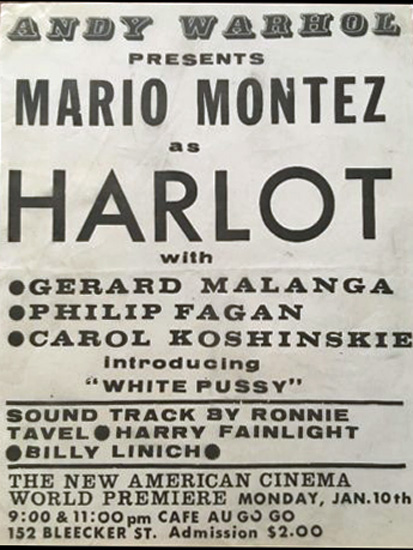
Flyer for the "World Premiere" of Harlot on January, 10, 1965
Harlot was also listed on an ad in the Village Voice for an event happening on January 11, 1965:
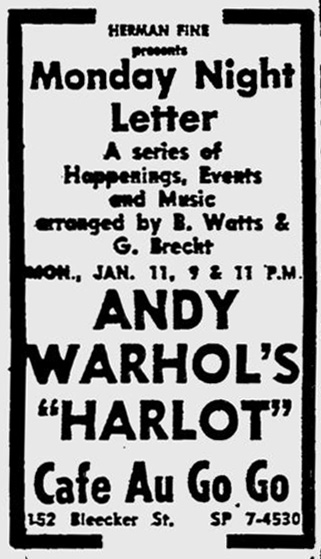
Village Voice ad, January 7, 1965
Warhol realized that if they were going to have sync sound, they would need a lot of dialogue. When he saw RON TAVEL at a Wednesday night poetry reading at the Cafe Le Metro, Warhol was impressed by the reams of paper that Ronnie was surrounded by and invited him to the Factory to sit in a lounge chair off-camera and talk while they shot MARIO MONTEZ in Harlot.
Mario was in a lot of off-off-Broadway plays and “doing a lot of underground acting for JACK SMITH and RON RICE and JOSE RODRIGUEZ-SOLTERO and BILL VEHR,” in addition to his regular job working for the post office. (POP90-91)
After Harlot, RON TAVEL continued to write scenarios for Andy, including THE LIFE OF JUANITA CASTRO, HORSE, VINYL, HEDY, and KITCHEN. (POP91) He also wrote a musical for Warhol called Piano but the project failed to materialize. (AWM56).